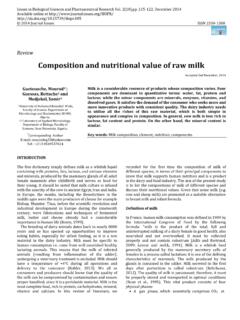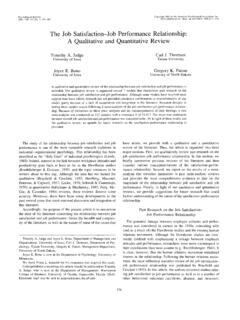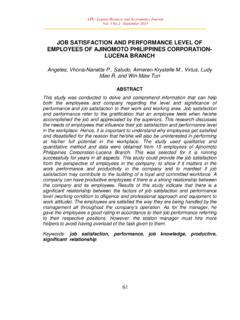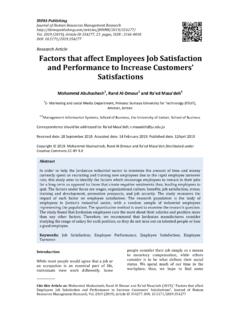Transcription of The relationship between job satisfaction, job performance ...
1 Issues in Business Management and Economics (1), pp. 1-8, January 2016 Available online at Copyright 2015 Author(s) retain the copyright of this article ISSN 2350-157X Original Research Article The relationship between job satisfaction , job performance and employee engagement: An explorative study Received 15 December, 2015 Revised 6 January, 2016 Accepted 11 January, 2016 Published 20 January, 2016 Abdulwahab S. Bin Shmailan Department of Management and Information Technology, Jubail Industrial College, Box 10099, Jubail Industrial City, 31961, Saudi Arabia. Author s Email: Successful organizations know that employee satisfaction , performance and employee engagement are crucial. This research was conducted to examine what contributes to a satisfied employee by examining a number of factors such as job fit, good communication, appreciation and clear objectives.
2 The study will also look at the roles of the organization and individual in employee satisfaction . job performance , another key success factor for organizations, will also be examined. The link between employee satisfaction and performance findings will be illuminated and related examples of what can be done to improve both variables will be provided. Finally, this study discusses employee engagement which combines the above topics and much more including definitions, organizational success, and how to develop a successful employee engagement program. This study will also provide compelling information that will help to understand the advantages of having satisfied and high performing employees as well as using the power of employee engagement to be competitive and profitable. Key words: Employee satisfaction , job performance , job satisfaction , employee engagement.
3 INTRODUCTION There has been a great deal of research conducted on how organizations can become more competitive and profitable. Part of that research indicates that there are three factors that successful companies share: job satisfaction and strong performance for employees as well as engagement with the business. job satisfaction can come from allowing employees to be self-directed and strong relationship with fellow workers (Lin, 2007). Sometimes this requires a tweaking of organization goals to boost employee motivation (Kivininiemi et al., 2002). In Arab countries, there is defiance and leaders blocking the importance of letting people have a say and their ideas, even if it can improve organizational performance (Al Raisi et al., 2011). In the Arab world, it is very difficult to change the culture and there is distaste in changing their idea.
4 They want to keep things as they are (Al Raisi et al., 2011). performance as defined by Campbell (1990) is what the organization hires one to do and do well . Performing employees help leaders to create excellent organizations. There are factors that impact on job performance ; one is education. According to Ng and Feldman (2009), having the right education can have a strong positive effect on employee job performance . There are times when a new employee is a good fit for a void that the organization needs to fill and improves performance in that job (Muchinsky and Monahan, 1987). If a person is in the right job, there is a direct link to performance (Edwards, 1991). There is more commitment, satisfaction , and motivation for the employee and better overall performance for the employee (Li and Hung, 2010). Employee engagement is a broad topic that discusses the symbiotic relationship between employees and the Issues Bus.
5 Manag. Econ. 2 organization. It also links employee satisfaction and performance . Engaged employees have a level of commitment and emotional attachment to the organization (Demovsek, 2008). Employees develop a bond with an organization and that creates better business. If that emotional connection to their career, relationships with other employees and the organization are present, they perform better and serve the organization better (Scarlett Survey). The objective of this study is to answer the following research questions: 1) Study and understand the factors influencing employee satisfaction and job performance . 2) Determine the correlation between job satisfaction and performance and employee engagement. Contribution of the study The following are the contributions that this research study provides: 1.
6 Help organizations understand the importance of having the right people in the right position. 2. Encourage organizations to increase the level of employee satisfaction and performance . Provide organizations and staff with information on the benefits of having high employee engagement and how engaged staff contribute to success. Literature Review Employee satisfaction Successful organizations depend on the high performance of their employees to meet their objectives. In order to achieve their strategic aims and keep their competitive advantage, their employees must perform at high levels (Lado and Wilson, 1994; Dessler, 2011). Organizational behavior philosophers believe that it is also crucial to have the right employees for the right jobs (Kristof-Brown et al., 2005). The person-job fit is important because it determines whether or not the employee is well-suited for the job (Zheng et al.)
7 , 2010) and whether the employee will be committed and productive to the organization (Rousseau and McLean Parks, 1992). Examining job performance as a concept can be done in a number of ways including the ability of an employee to achieve their targets and organizational standards (Eysenck, 1998; Maathis and Jackson, 2000; Bohlander et al., 2001). Campbell (1993) defined performance as synonymous with behavior which is something that a person actually does and can be observed . According to Campbell (1990), employees are hired to perform with efficiency and effectiveness (Aziri, 2011). Organizations need to understand that employees have their own requirements and personal wishes that need to be considered. This can determine if the employee feels positive or negative about the organization and needs to be treated individually (Schermernorn, 2010).
8 How satisfied an employee is with his or her job depends on their values and motives (Siddika, 2012). Researches in the past have examined a number of elements that can affect job performance . Jaramilloa et al. (2005) and Al Ahmadi (2009) showed that a crucial element is employees commitment to their job. There is also a strong connection between being satisfied at their job and their performance (Gu and Chi, 2009). Sarmiento and Beale (2007) and Al Ahmadi (2009) studied the connection between education and job performance and obtained a surprising result which was a negative connection. Ng and Feldman (2009) found the opposite that education was a positive influence on job performance . Other studies by Karatepea et al. (2006) and D Amato and Zijlstra (2008) found that a person s self-motivation and efficiency has a positive effect on job performance .
9 The theoretical concepts of fit according to Kilchyk (2009) states that either the supplementary versus complementary view or demands-abilities versus needs-supplies view is also known as supplies-values fit . In an earlier research conducted by Muchinsky and Monahan (1987), they indicated that work can be divided into two extents of which the first is the supplementary versus complementary while the second is the demand-abilities versus needs-supplies . When a person s distinguishing traits are similar to their organizational environment, then it is a supplementary fit (Sekiguchi, 2003). The fit is complementary when the traits of an individual fill the vacuum or emptiness of an organization thus broadening the organization s capabilities (Muchinsky and Monahan, 1987). Research in the 1990 s focused on the person-job fit with regard to the employee s wishes (employee related) and organizational mandates (job related).
10 Edwards (1991) determined that employees with high person-job fit produce better results. There are a number of variables for person-job fit identified in the 1990 s researches (Caldwell and O Reilly, 1990; Edwards, 1996), including commitment to the job (Behery, 2009; Kristoff - Brown et al., 2005), job satisfaction (Erdogan and Bauer, 2005; Kristoff - Brown et al., 2005) performance and personality (Erdogan and Bauer, 2005). Organizations must meet their strategic aims and advantage in the marketplace by employing and keeping high performing employees (Lado and Wilson, 1994; Dessler, 2011). In SMEs, the level of high performing individuals is lower because in many cases their employees may not have the right skills (Saleh and Ndubisi, 2006) and the ability to perform at high level standards (Aris, 2007).






